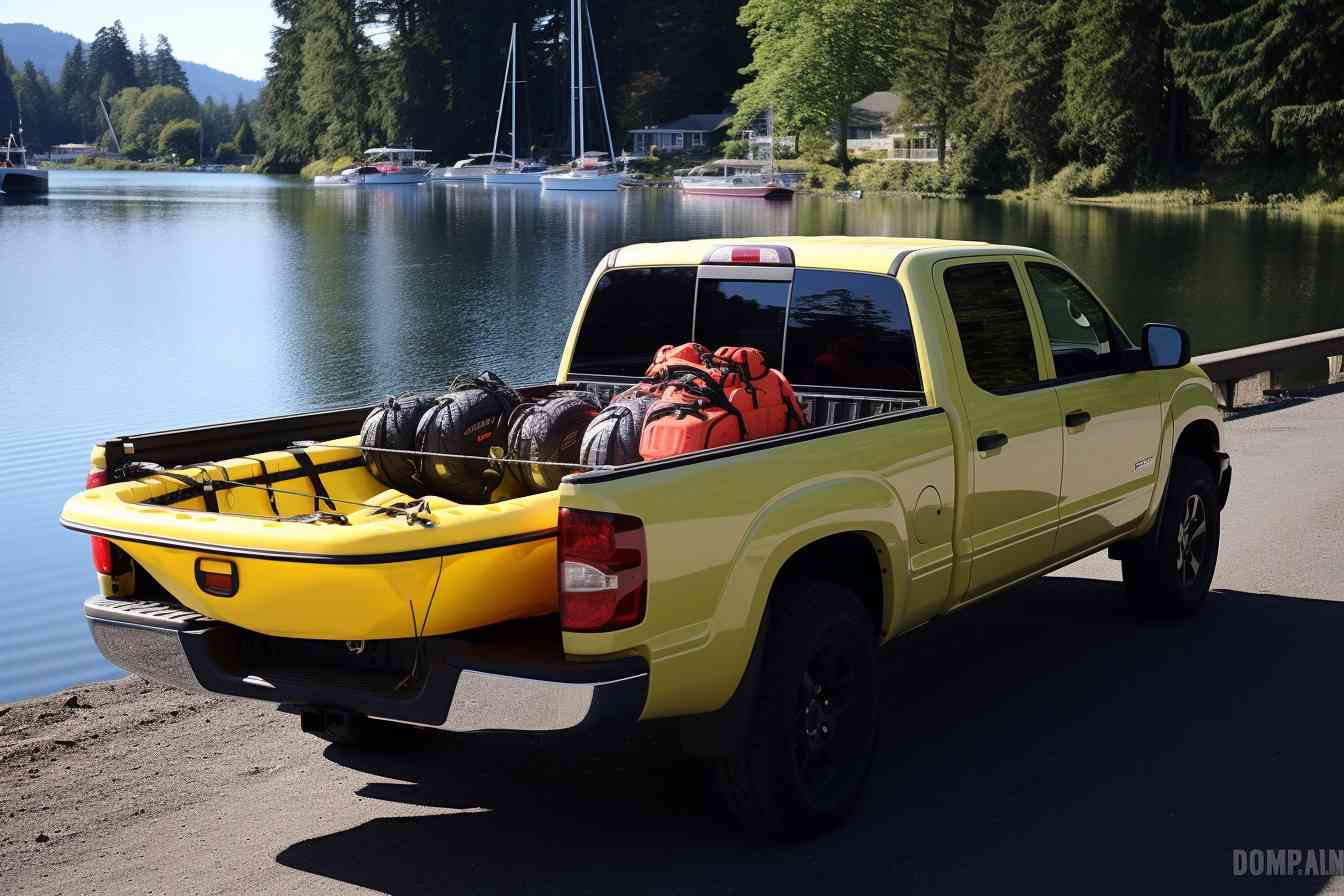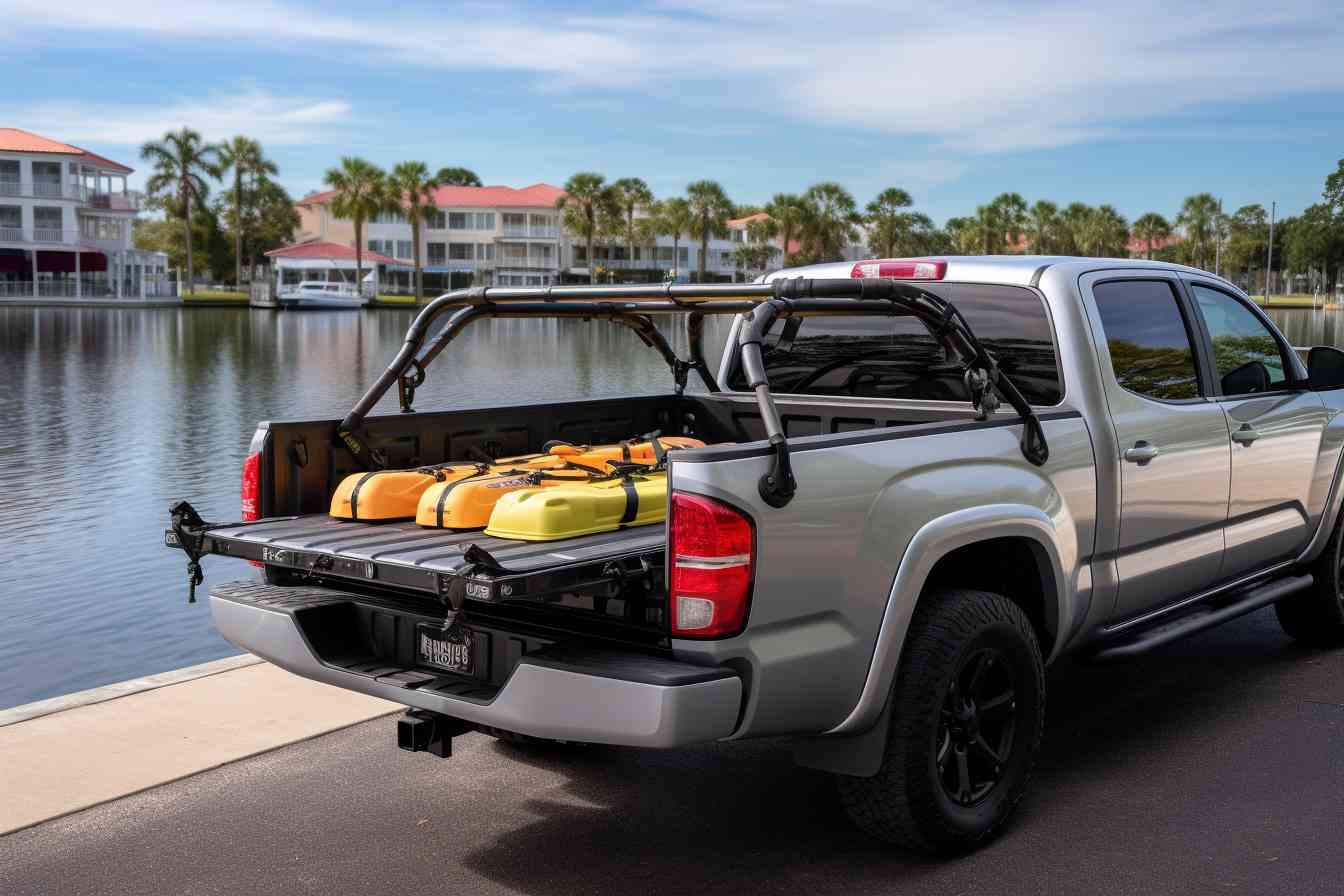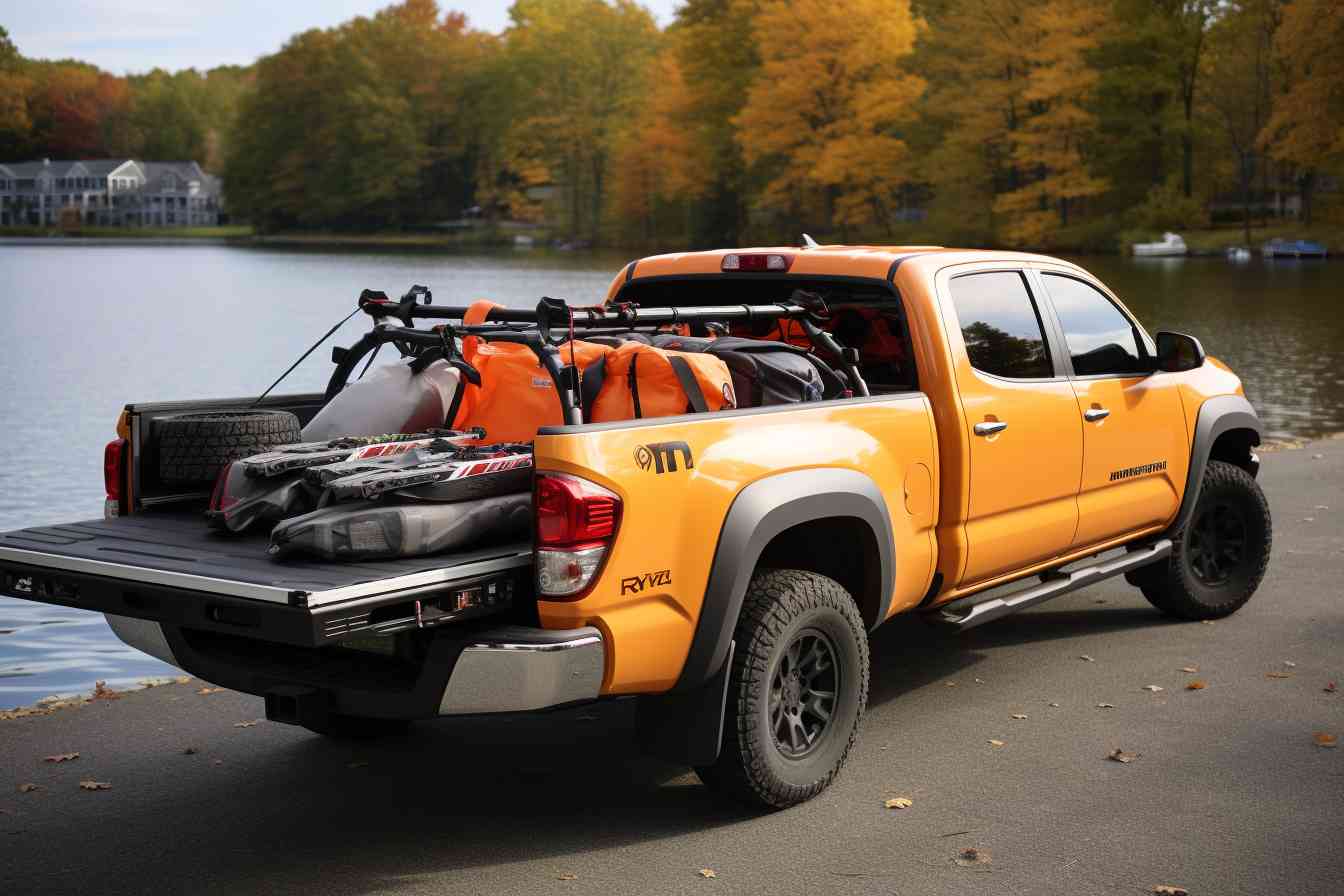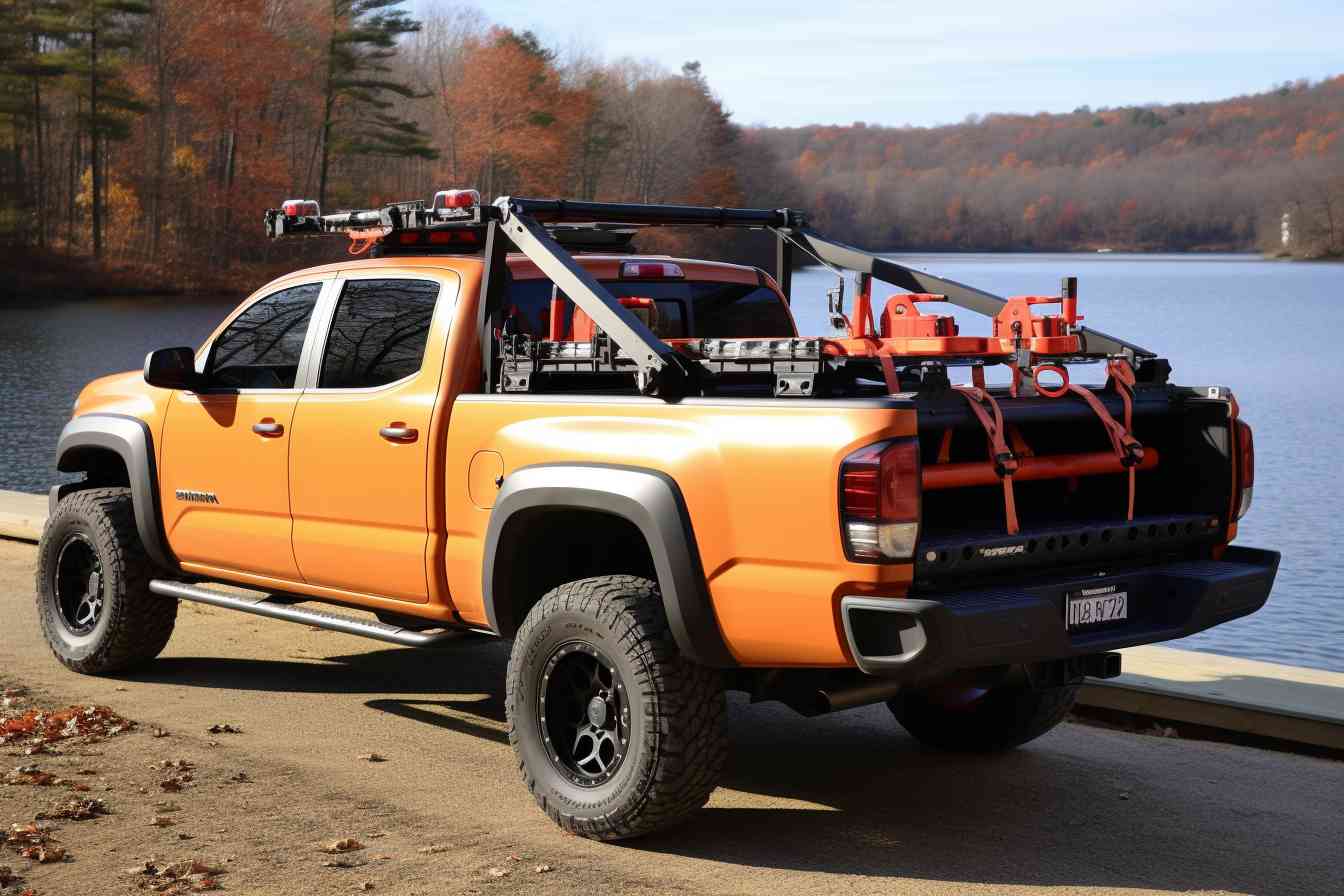Intro: How To Transport A Kayak In A Truck

Well, here we are – you, me, and this big ol’ thing called a kayak. How do we get it from point A to point B, you might be wondering? Hint: we’re not going to just plop it in the truck bed and hope for the best. Nope, transporting a kayak in a truck needs some thought and a bit of careful planning. Let’s talk about it, shall we?
First things first – preparation. It goes without saying, but I’ll say it anyway, you’ve got to make sure your kayak doesn’t suffer any damage during transportation, and neither does your trusty truck. After all, both of them are your prized possessions, right? So, get yourself some good quality foam blocks or a kayak rack—that’s non-negotiable. Attach them securely to your truck, and you’re one step closer to starting your waterside adventure.
Next, loading the kayak onto the truck—they don’t call it the heavy lifting for nothing! The best way is to gently lift and slide it onto the rack or foam blocks. Sounds easier than it is, trust me. Better yet, get a helping hand if you can, saves your back, and makes the job quicker and smoother.
Now, remember, just like good friendships, it’s all about balance. Position the kayak so it occupies the center stage on your foam blocks or the rack. We don’t want any teetering, now do we? So, a little adjustment here and there is necessary until the kayak looks secure and balanced.
Critical point here: secure the kayak. “But I just placed it on the rack!” – you yell out. I hear ya, buddy, but the road can be rough, and winds unpredictable. Strap the kayak down properly with some strong ropes or straps, especially at the bow and stern.
There you have it – your kayak is safely strapped in, ready to hit the road. You see? It’s not just a splash in the pan. But boy, when you’re floating on that serene lake or charging down those white-water rapids later on, you’ll agree – it’s well worth it!
Can A Kayak Fit In The Back Of A Truck?

Boy oh boy, aren’t we having a real boater’s conundrum! Well, I’m just tickled to help you out here. You bet your paddles it can! As long as you’ve got a pickup truck, you’re in business.
It’s not terribly complicated to pull off. You see, most pickups have beds that are about 5 to 8 feet long. Now, kayaks… they usually range from about 8 to 14 feet. So unless you’ve got yourself a pipsqueak of a kayak, it’s going to stick out a good deal. But that’s okay, it’s perfectly legal as long as we’re taking the right precautions.
Make sure you’ve got some ratchet straps on hand. These babies will secure the kayak like a charm. Now, don’t be a “ratchet rookie” and just throw ‘em on there without a care. You’ve gotta do it right, my friend, or else you could end up with a real mess on your hands. Make sure you tighten it down, but not so tight you could play “Taps” on it! A good rule of thumb – Courtesy of yours truly – is if it doesn’t move, it’s snug enough.
You also need to secure it front and back. Some trucks have tie-down points, which makes it a cinch. If yours doesn’t, a couple of tow straps will do the trick. And remember to hang a red flag on the end if your kayak sticks out more than 4 feet from the rear – it’s the law. You wouldn’t want any roadsters getting up close and cozy with your precious cargo, would ya?
But hey, with a little bit of elbow grease and a whole lot of TLC, you’ll have your kayak nestled snugly in the back of your truck in no time. So don’t sweat it, you’ve got this!
How To Tie Down A Kayak In A Truck Bed
Alright, let’s dive in and navigate the waters of securing a kayak in a truck bed, should we?
-
First and foremost – the importance of correct positioning. Make sure that your kayak is perfectly balanced in the truck bed and there’s no bending or twisting that could damage it during transportation. Spread the weight evenly for a smoother ride.
-
Use the right tools – ratcheting straps, cam buckles, or bungee cords are your best friends in this endeavor. Don’t skimp on quality here, my friend. The last thing you want is your kayak tumbling off the truck while you’re cruising down the highway.
-
Double-check your tie-down points. If your truck doesn’t have built-in tie-down points, you might need to get a little creative. You can use the truck’s bed railing or frame as alternative tie-down points in a pinch.
-
Understand proper strapping technique. This might be a bit tricky, but believe me, it’s worth the struggle. Get the strap underneath the kayak, pull it up and over, and secure it tightly. It’s the best way to ensure that your kayak stays put.
-
Regularly inspect your tie-downs. It’s essential to stop and check your tie-downs during the journey. They may loosen up with time and need readjusting.
-
Protect the kayak and the truck. Consider using padding between the bed of the truck and the kayak to prevent scratches or damage to either party.
-
Finally, always have a plan for unloading. Know how you’re going to safely remove your kayak from the truck once you’ve reached your destination. It’s just as important as securing it!
So, there you go. Hopefully, this clears up any ambiguity you might have had about how to properly secure your kayak for transportation. Don’t get all tied up in knots over it – with a little practice and these tips in mind, you’ll be able to transport your kayak safely and efficiently. Let’s paddle our own canoe and transport our kayaks confidently, shall we?
Can You Put A 10 Foot Kayak In A 5 Foot Truck Bed?

Alright, let’s dive into matters straight away. Can you put a 10-foot kayak in a 5-foot truck bed? Surprisingly, it’s not only plausible but also feasible to transport a 10-foot kayak using a 5-foot truck bed . You’ll just have to pull a few tricks out of your sleeve to make it work.
First off, it’s crucial to ensure the safety of everyone on the road, and that includes your precious kayak too. Now, I can almost hear you wondering, “But how the heck do I even begin?” Don’t fret, let us unravel this together.
Here’s the deal — depending on the size and weight of your kayak, it may hang over the tailgate. Don’t let that discourage you, though. There’s a simple workaround. Start by placing the kayak flat in the bed of your truck. Usually, about half of it will be hanging over the tailgate, but that’s alright.
What you’ve gotta do next is crucial — secure it with ratchet straps. Properly fastened straps not only help stabilize your kayak but also prevent it from sliding around. Make sure the straps are tightly secured around the kayak and the truck bed. Try giving it a little wiggle to see if it budges; if done properly, it shouldn’t.
Lastly, don’t forget to tie a red or orange flag to the end of the kayak that’s sticking out. It’s actually required by law in most states, and it signals to the drivers behind you that there’s a long load ahead. Trust me, this small precaution can save you from a world of trouble.
So, you see? Transporting a 10-foot kayak in a 5-foot truck bed isn’t as daunting as it may initially seem. With some careful maneuvering and proper securing, you’re good to go on your next aquatic adventure. Safe travels, my friend!
12 Foot Kayak In Truck Bed
Alright, let’s dive right into a scenario where you’ve got a 12-foot kayak and a truck bed in play. How in the world are you going to make it work and transport this beast of a boat to your favorite kayak spot? Here are some thoughtful suggestions that might ease your worry:
- Tailgate Carry Approach: Drop your truck’s tailgate and slide the kayak onto the truck bed. The tailgate down allows for an extra space that’ll help accommodate the length of the kayak.
- Use Ratchet Straps: Keep your kayak secure with ratchet straps. Yes, twine might be cheap, but this isn’t the time for penny-pinching. Your kayak’s safety, and other motorists’ safety, are on the line.
- Pool Noodles for Kayak Protection: Use pool noodles by cutting them lengthwise and placing them over the edges of your kayak for added protection. Your kayak and your truck bed will thank you for it.
- Tilt It Up: If the kayak still hangs out too much, try positioning it diagonally. It may take up more room in the bed, but could allow your tailgate to close.
- Red Flag: By law, you might need to attach a red flag to the end of an overhanging kayak. Always better to be safe and legal rather than sorry.
- Bed Extender: A bed extender is a nifty device that gives you more real estate to work with. It extends out from your hitch receiver to support the overhanging part of the kayak.
- Padded Roof Racks: If you just can’t make the truck bed work, try using padded roof racks. It’s an added cost, but if you’re regularly transporting your kayak, it could be a worthy investment.
- Secure Both Ends: Don’t forget to secure both the stern and bow of your kayak. This will provide extra security especially when you’re driving at high speeds.
- Regular Checks: Don’t forget to stop and make sure your straps are still tight after the first few miles. You’ll be heartbroken if your precious kayak starts drifting back onto the interstate.
- Dry Run: Finally, do a dry run before your kayaking expedition. Nothing like a real-world test to find out if your kayak transportation strategy is up to snuff.
It’s a bit of a challenge, sure, but it’s one that can be conquered with a little bit of clever thinking and some careful preparation. Safe travels to you and your kayak!
How Do You Transport A 10 Foot Kayak?

Well, let’s jump right into it, shall we? Transporting a 10-foot kayak can sure feel like a daunting task, but I promise you, it isn’t as tricky as it might seem. Firstly, you gotta have a good ol’ truck bed extender. It’ll give you some extra length and make sure that your kayak doesn’t get all wobbly while on the road. But hey, do remember that the kayak itself needs some protection too. That’s where foam blocks come in – they act as nifty little paddings to prevent damage to your precious vessel.
Alright, let’s get into the nitty-gritty of it, the actual loading of the kayak. I suggest a two-man operation here. Literally, grab a compadre to help you out. It’s all about team work, folks! Pick up the kayak from either end and carefully lay it in the bed of the truck. The kayak should be pointing in the direction of travel– that’s a no-brainer, right?
Once it’s safely nestled, use straps (ratchet straps are my personal favorite!) to secure the kayak to the bed extender and the truck itself. You want that baby snug as a bug. And don’t forget, strap it both at the front and the back for safe measure to ensure it doesn’t shuffle around. Flagging the back of the kayak isn’t a bad idea either, especially if it sticks out quite a bit from the truck.
So there you have it! That’s the basics for transporting a 10-foot kayak. It might sound like a herculean task initially, but trust me, once you’ve done it a few times, it becomes as easy as pie. Or a walk in the park, depending on your idiomatic preference. Just remember – safety first, both for you and your kayak. Happy travels, my fellow kayaking enthusiasts!
Do You Transport Kayaks Up Or Down?
As a seasoned kayak enthusiast, one question I’ve regularly wrestled with is, “Should I transport my kayak upright, or should it be upside down?” Now, there’s no one-size-fits-all answer here, folks. It comes down to personal preferences and the specific design of your kayak.
If we’re talking about plastic kayaks, I’d suggest loading them upside down. Why, you ask? Well, plastic can become distorted due to heat. With the hull exposed to the blazing sun, gravity may contribute to the warping. So, to prevent this heat-induced distortion, flip that plastic kayak over!
However, if your kayak is composed of more heat-tolerant materials, such as fiberglass or carbon, you could practically go either way. Personally, I’d still lean towards upside down, mainly for the extra stability that the hull’s design naturally provides.
So now you’re thinking, “But what about potential damage from the truck bed’s ridges or any gear I might be carrying?” I’ve got ya covered. Just place a couple of soft yet durable items (think old carpets or sleeping bags) on the truck bed to create a cushion.
All in all, it’s a toss-up, really. You gotta consider your vehicle, the kayak’s material and design, and your own peace of mind. Just remember – secure and stabilize! That’s the golden rule when it comes to transporting your trusty kayak in a truck. And hey, don’t forget to double-check everything before hitting the road. Better safe than sorry, am I right? Happy kayaking, adventurers!
Final Verdict
Alright, we’ve reached our final destination—our final verdict on how to transport a kayak in a truck. Now ain’t this a fun topic? Without a hitch (excuse the pun!), I’m genuinely thrilled to share this with you.
After all our discussions, you’d probably agree with me that transporting a kayak in a truck isn’t as thorny a task as it first seemed, eh? It simply requires a bit of forethought, the right equipment and a dash of patience.
So what’s the final take? Well, as it turns out, the secret is all in the details- ensuring your kayak is secure, and your drive is smooth. Having a proper rack system on your truck is the first crucial step. It’s game-changing! With the right rack system, you can easily tie down the kayak, and it provides stability, which, let me tell you, is an absolute must for any trip. So, don’t skimp on that!
Next up, always ensure your kayak is safely tied down. Double-check those straps and ropes, my friend. Remember, safety is not just about you, but also about others on the road. And let’s not forget about protecting your kayak from any possible damage.
In conclusion(scratch that, it’s the final verdict), it’s safe to say that the art of transporting a kayak in a truck comes down to balancing safety and convenience. It may seem a bit daunting initially, but once you get the hang of it… Well, it’s smooth sailing— or should I say, smooth driving from there! And voila! There you have it— the end of our journey. Now go out there and make some waves!
Frequently Asked Questions
1. How can I transport my kayak using a truck bed?
You can lay your kayak fully inside the bed of the truck if it’s long enough or support it on the tailgate if it sticks out. Additionally, you can use a bed extender or a roof rack system to ensure it’s secured well. Remember to use ratchet straps, ropes or bungees to keep the kayak from moving during transport.
2. How do I secure my kayak in the bed of a truck?
To secure your kayak, you’ll need tie-downs or ratchet straps, which should be attached to secure points on your truck. The kayak must be tied down at the front and rear to prevent any movement during travel. Ensure that it’s not excessively tight to avoid damaging the boat.
3. Can I transport a kayak without a rack?
Yes, you can. While a rack can be a handy method of transporting a kayak, it’s not mandatory. You can either use a bed extender, lay your kayak flat on your truck bed, or just put it on foam blocks if you don’t have a rack.
4. How can I protect my kayak from getting damaged while transporting it in my truck?
Using padding or foam blocks can help protect the hull of your kayak from scratches or denting. Also, ensure it’s not tied too tightly, to avoid undue pressure which could cause damage.
5. What is the safe speed when driving a truck with a kayak onboard?
Always consider the weather conditions and road situation. Typically, it’s advisable to drive at moderate speed to ensure the kayak doesn’t shift or fall. You shouldn’t exceed the posted speed limits.
6. How many kayaks can I transport at a time in my truck?
The number will mainly depend on the size of your truck bed and the width of the kayaks. Typically, you can transport one to two kayaks comfortably. However, you must ensure they are all well-secured.
7. What is the most secure method to transport a kayak in a truck?
The most secure method is using a good-quality kayak rack and securing it with strong ratchet straps. Additionally, using a bed extender can also provide added security, especially for longer kayaks.
8. How do I tie down a kayak in my truck without damaging the truck paint?
You can use foam blocks, padding, or even pool noodles at the points of contact between the kayak and the truck to protect both the truck paint and the kayak from damage.
9. Can I transport my kayak in a truck if it’s longer than the truck bed?
Yes, it’s absolutely doable. You’ll need to rest the bow of the kayak in the truck bed, letting the stern hang out in a truck bed extender, or use a roof rack for full support. Remember to flag the overhanging part for safety.
10. Do I need any specific legal permissions to transport a kayak in my truck?
No special legal permission is necessary for transporting a kayak. However, you must comply with road safety regulations such as properly securing your load and indicating if it extends beyond your vehicle. Also, some states may have specific rules about overhang, so it’s always wise to check with your local transport authorities.

